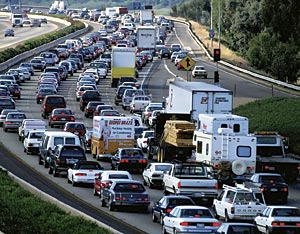The bigger picture
There needs to be a caveat here, though. Density is a plus word today, and it’s often said that New York’s Manhattan is the greenest community in the U.S., because its high density leads to low per-capita consumption of energy for heating, cooling, and transit. But throw the frame a little wider, and you realize that a lot of the food for New York is coming in carbon-powered trucks and airplanes from California, or even Brazil or China. Maybe there’s a more optimal city size, one that would permit us to raise more food nearer home.

A bigger gas tax and a revitalized rail system could help reduce traffic and pollution.
Create a great national rail system. It’s embarrassing for an American to get on a bullet train in France, Spain, or Japan. Here, as in other ways, we’re falling into the status of a low-tech, third-world nation. Amtrak, which I often take, is pathetic by comparison — slow, unreliable, with poorly designed passenger features and services. People argue that the U.S. is too big to be served by trains, and it’s true I wouldn’t take one from coast to coast. But there are several potential regions, each as big as a medium-size country, that could benefit, the way the BosWash corridor in the east does today. Trains, as everyone knows, are far safer and consume far fewer resources than other modes of travel or shipping. And like my gas tax, the rail system would tend to center a, pulling us together in communities, gathering, perhaps, not too far from the station. The new rail system should have at least the priority that the interstate highway system had in the 1950s and ‘60s.
Stop development from places where floods happen. I can’t believe the way developers are building at the water’s edge of my own city of Boston, and many others. Guys, the water is rising. Nobody knows how high it will go, but it appears certain that it’s too late to prevent a drastic problem. I’ve always thought that a rational government would long ago have banned all building on the barrier islands, from New England to Texas. They’re basically sandbars, and they’re all doomed to suffer a hurricane sooner or later—and in some cases, to be wiped out completely. What we should have had, instead, is a Barrier Island Park, a national necklace of waves and beaches. I feel the same way now about oceanfront city building. Maybe we should pull back? It’s time to at least begin to think about what kind of controls might be appropriate.
The other side of this coin concerns the regions that don’t have enough water. The American Southwest has long been the fastest-growing part of the country. Yet cities such as Phoenix and Las Vegas are like hospital patients on permanent life-support. They depend wholly on all those intravenous tubes that bring them water — for drinking, for cooling, for irrigation. But water reserves are being drained. I know it sounds like socialism, but especially as we face unpredictable climate change, it might be wise to figure out some fair way to discourage rampant development in arid lands. Sooner or later, I suppose, there will be a successful method of desalinization. But the mind boggles at the thought of pumping vast amounts of water from the ocean to the desert.
On the other hand, don’t act like God. I’m quoting Bill Mitchell, the former dean of the School of Architecture and Planning at MIT, in his terrific new book The Greatest Architect in the World. Writes Mitchell: “God’s limitation was his authoritarian, top-down approach … He had never heard of Jane Jacobs, and he had no idea that the most complex, diverse, and interesting cities emerge gradually over many years, from countless incremental interventions and adjustments. It’s a bottom-up process, without a master plan. One thing just leads to another, and the most amazing results evolve in completely unexpected ways.”
I totally believe that, but … There is always a master plan, of some kind, from some source. Jacobs lived in New York, a city, like so many, shaped by the grid. A good city needs both a plan and what I’ll call an insurgency. There must be an order (some of it provided, top-down, by designers, planners, and the government), and there must be an insurgency, a bubbling up of private initiatives from the bottom, in opposition to the plan.
Emerson said it long ago: “There is always an establishment, and there is always a movement.” Or as Paul Verlaine put it, “Mankind is permanently threatened by two disasters; they are order and disorder.” A good city is in a permanent state of tension between the two.




Post a comment to this article
Report Abusive Comment